 By Pepper Parr By Pepper Parr
May 1st, 2020
BURLINGTON, ON
She isn’t ready for the big stage – not yet
And she needs to let the microphone slide into other hands.
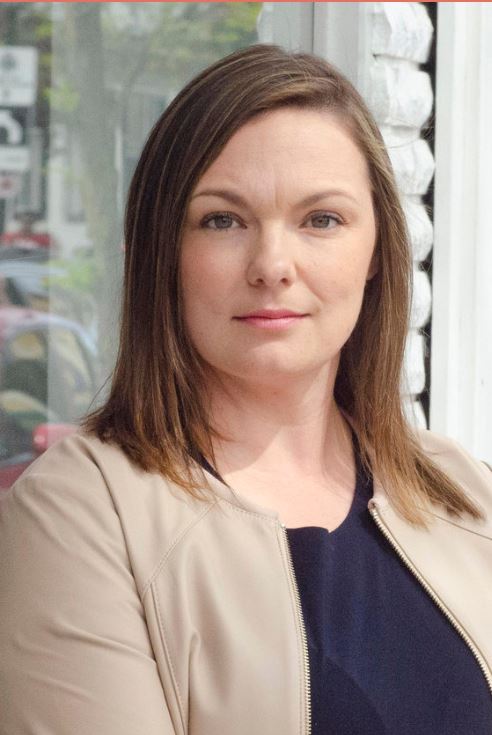 For her first Zoom solo – she did Ok. On the positive side – Lisa Kearns deserves credit for taking a shot at using Zoom to talk to her people,
She drew 35 people – nice to see Jackie Isada again. I think Paddy Torsney should have been less blatant with the wine glass.
Kearns chose to cover the complete waterfront – her audience was well plugged in – they didn’t need be told to wash their hands.
Kearns likes the new TelePlus program the city Parks and Recreation has rolled out. Few fully understand what the city has gotten itself into. Time will reveal where the problems are.
Two parts of the presentation were disturbing – before questions were permitted Jenn Morrison from CLV development that is going to put up seven structures that range from 29 – 37 floors, got to make comments. There was no opportunity to discuss that development in more detail.
The rules appear to be a bit different for this development.
We did learn that those sites that are permitted to continue construction can work from 6:00 am to 10:00 pm used to be 7 to 7.
If a development site has risen above grade it is deemed essential and can continue building.
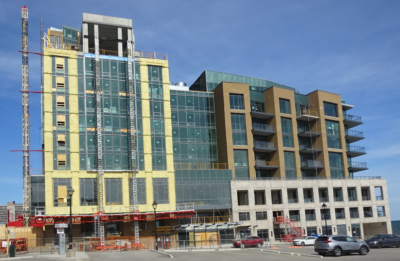 Section on the right is residential – construction can continue – section on the left is a hotel – not essential – continued construction not permitted. Bridgewater site that looks as if it is going to be under construction for some time. The residential parts can continue with construction – but the hotel which is on the west side cannot – hotels were not deemed essential.
Cyclists are causing a lot of people considerable grief. They are on pathways that were not meant for bikes and they “just fly by” as one commentator said.
There was a “hint” that a way might have to be found to limit the number of people who access the park – where you are expected to walk with no dilly dallying or sitting on a bench for a break.
It was a good effort – do it again – but listen more and talk less.

 By Pepper Parr By Pepper Parr
April 29th, 2020
BURLINGTON, ON
In normal times the administration of the city is in the hands of the City Manager who works at the will of council.
Council also issues Staff Directions which set out some very specific tasks they expect the City Manager to ensure gets done on time and within the budget.
But these are not normal times.
On March 21st, Mayor Marianne Meed Ward declared a State of Emergency and the role city council played going forward was severely diminished. When the province declared a State of Emergency that meant many of the instructions as to what a city had to do came from the province.
The City manager was, to a large degree bound by what the province was calling for.
So – what was a mere city councillor to do?
In Burlington several of the Councillors began to chafe a bit and worked on the city manager to get more in the way of information as to just what was happening day to day.
 City manager Tim Commisso: With most of the power over local decision making – there might be some reluctance to give it back to council. As Chair of what is known as the Emergency Coordinating Group (ECG) the city manager takes the steps he thinks are necessary to ensure the safe operation of the city and while city hall is closed to the public there are some people working on tasks that can only be done from within city hall.
The ECG is made up of a large number of people. They meet twice a day on-line and make sure that what needs doing is done.
My understanding is that the City Manager is now giving the city Councillors an update once a week as to what was done and why.
That information however is not being shared.
If the Councillors do have a weekly report they aren’t sharing that information with their constituents. One wonders why.
One could also ask why the City Manager doesn’t share those reports with the public.
An opinion piece in the Toronto Star on April 27th raised some serious questions under the headline: “Use of municipal emergency powers has gone too far.”
Anneke Smit and Alexandra Flynn argue that “meaningful, participatory governance has been thrust aside” in the name of keeping people safe while a virus kills hundreds across the province.
“Municipalities have very weak powers in Canada’s constitutional framework, cities are subject to provincial whims when it comes to both stable funding and political structures. Local governments are overlooked in conversations about democracy and governance, yet they are responsible for many of the decisions that most directly affect our daily lives.
“Canadian municipalities have made big decisions from the start of the crisis, such as enforcing physical distancing; dealing with the functioning — or not — of public transit; access to parks; and deciding whether to dedicate extra space for pedestrians and cyclists to name a few.
“Canada’s municipalities are not governed by a “strong mayor” system. This means that city council as a whole makes decisions, not just mayors. Provincial state of emergency legislation changes this. In most provinces, municipalities have the power to declare their own state of emergency. In its survey of 65 of the largest Canadian municipalities, the Canadian Urban Institute (CUI) counts 56 that have done so, in some cases for the first time in history, leaving mayors able to bypass city council votes and act unilaterally.
“While B.C.’s emergency legislation requires a mayor to consult the rest of council before they act, this is not the case in most Canadian provinces. CUI counts 10 of the surveyed cities having cancelled city council meetings during COVID-19 (including Toronto, Halifax, Windsor, Winnipeg and Edmonton). The cancellation or diminishment of council meetings means residents won’t know who made what decisions, which questions were asked, or hear staff advice, and decisions on many key issues not immediately related to the pandemic are simply being postponed.
“What is more, 28 of the municipalities have also cancelled committee meetings, and 34 have cancelled public consultations. These meetings are the backbone of local democracy. They give the public a chance to directly weigh in on issues that matter to them in their communities.
“In the early stages of the pandemic, decisions had to be made quickly. A single, authoritative voice on behalf of a government was arguably necessary. Five weeks later, much of the dust has settled, and we are left with unaccountable local decision-making in many communities and no immediate end in sight to states of emergency.”
That pretty well sets out what is taking place in Burlington.
It doesn’t have to be this way – the elected members of council can agitate and advocate for a more open process – and those with the courage to do so might better serve their constituents by being more vocal.
All seven were elected and they speak as the will of council.
The Gazette for one would like to hear that will expressed verbally.
 Elected less than two years ago – they have now let someone else make the decisions. Related news stories:
Mayor declares State of Emergency
What does a State of Emergency mean?

 By Pepper Parr By Pepper Parr
April 29th, 2020
BURLINGTON, ON
As the Gazette was putting together the idea of making a couple of thousand 100% cotton face masks with ties rather than elastics someone suggested we reach out to the Burlington Caremongers Facebook page.
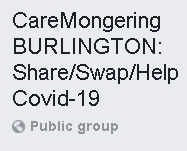 There we found Beth Martin who built an organization that in the first week of being active, raised $2500 for Food4Kids Halton. They have been highlighting Halton charities every week. They connected community members who are in immediate need with food and necessities; their members have picked up and dropped off groceries and pharmacy orders. There we found Beth Martin who built an organization that in the first week of being active, raised $2500 for Food4Kids Halton. They have been highlighting Halton charities every week. They connected community members who are in immediate need with food and necessities; their members have picked up and dropped off groceries and pharmacy orders.
Others have been making masks, scrub caps, button headbands and scrub tops for front-line healthcare workers. Several times, we have posted anonymously for community members who did not want to be identified, and have received overwhelming offers of assistance.
There are now 6,177 Caremongers serving whoever needs help.
They moved very quickly on our Face Mask initiative – we had 10 volunteers before the end of the first day.
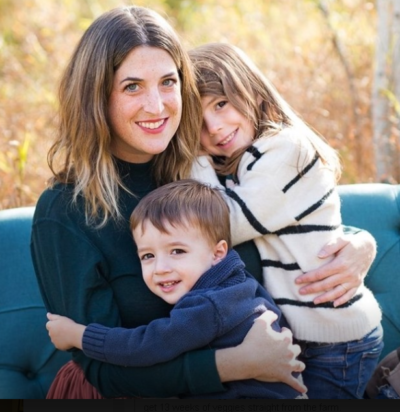 Beth Martin with her two children. So who is this Beth Martin?
She is the mother of two children, works at home with her husband after a number of years in book publishing for a major multi-national firm and then in advertising.
It was this collection of skills, plus a degree from Western University that taught her how to jump into the trenches and make things happen.
She had heard of a Caremongers group working out of Hamilton but they had a political bent that Martin wasn’t comfortable with.
She wanted something that would help people. Martin always uses the phrase “be kind” when she communicates with people.
When the Burlington Caremongers got going it became clear that there many different needs. Some people were looking for something; others had something to give. Martin began creating hash tags that directed conversations. #need meant you needed something; #sew meant you could sew.
It didn’t take long for a sewing group to develop; they got involved in making face masks for people in long-term care and nursing homes.
Martin put the Gazette in touch with that group.
Where will the Burlington Caremongers go from here? Wherever there is a need or someone who can help.
Martin is supported by ten people who serve as administrators of the site. With 6,000 + members they are kept busy.
It all works out wonderfully well – you just have to “be kind”.

 By Pepper Parr By Pepper Parr
April 29th, 2020
BURLINGTON, ON
A ray of sunshine when the Canada’s Craft Breweries said: “If there was ever a time for beer lovers across the country to support their local craft breweries, it would be right now.”
The comment was part of a plea to the federal government for financial support.
A survey of the craft breweries on the effects of the COVID-19 pandemic on the brewing industry in Canada. There was sufficient response from across the country to achieve a 95% confidence level with 5% margin of error.
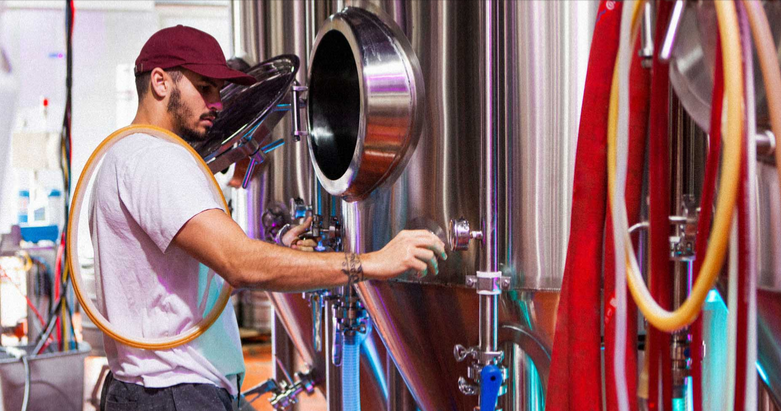 Let the suds flow. “Similar to many other industry sectors, craft breweries across Canada have been dramatically impacted by the current health and economic situation.” began Rick Dalmazzi, Executive Director of the CCBA. “For example, 44% of breweries reported a year over year revenue drop of over 50% in March, while another 25% were down over 25%. Over 77% of breweries anticipate that April will be the same or worse.”
There are over 1,100 craft breweries in every province and territory in Canada, with over 90% of them opening in the last decade. Many have helped to rejuvenate local economies and bring new employment to communities that have otherwise lost jobs. In provinces where it is legal, many breweries have added a home delivery service to help replace lost revenue. But it doesn’t come close to making up for their own restaurants and taprooms being closed, and keg sales to bars eliminated. The 317 survey respondents reported having to lay off 4,180 of their 6,409 employees, or 65%.
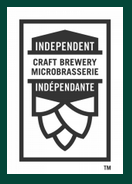 “Cashflow is the biggest problem”, continued Dalmazzi. “Many of our member breweries are still in their investment growth phase, and therefore marginally profitable if at all. Everyone’s doing whatever it takes to weather the storm as best they can. Fortunately, we’ve seen very few permanent closures, but that will change if current conditions extend into the summer.” continued Dalmazzi. “Cashflow is the biggest problem”, continued Dalmazzi. “Many of our member breweries are still in their investment growth phase, and therefore marginally profitable if at all. Everyone’s doing whatever it takes to weather the storm as best they can. Fortunately, we’ve seen very few permanent closures, but that will change if current conditions extend into the summer.” continued Dalmazzi.
The survey also found that craft breweries are stepping up to support the fight against COVID-19. Over 15% of respondents said that they are either making hand sanitizer or that their beer is being used to make it elsewhere. Most of the hand sanitizer being produced by breweries is for use within their local community.
“We are appreciative of the federal government’s wage subsidy and other programs. Ottawa has been very responsive to the financial needs of small businesses. However, our industry will need further support if it is to survive in its present form.” concluded Dalmazzi. “And if there was ever a time for beer lovers across the country to support their local craft breweries, it would be right now.”

 By Pepper Parr By Pepper Parr
April 29th, 2020
BURLINGTON, ON
Burlington is very good at stepping up to the plate and filling a need.
What caring people have managed to do is create a supply chain that gets food to the Food Bank who in turn deliver it to people who, in some cases, are self-isolating and not able to get out to buy food.
 Robin Bailey does a short web site broadcast most days – keeping donors and those who need food up to date. The Food Bank has exceptional sources and were recently given significant sums to buy food.
Fresh vegetables and eggs are now being delivered to homes. The Food Bank has succeeded in teaching people to call in for food rather than drop by the Food Band to pick it up – which cuts down on people getting too close to each other.
One of the gaps in this food chain is personal toiletries and canned goods.
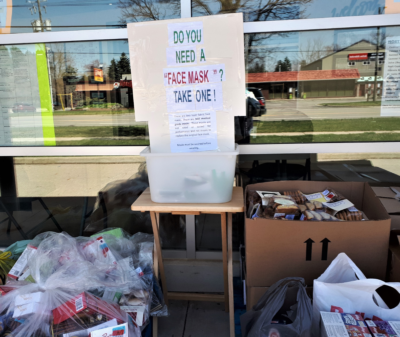 If you need a mask – take a couple of cans of food to St Matthews Anglican church on Plains Road in Aldershot and pick up a mask when you leave. St Matthews in Aldershot has stepped into the gap and is collecting toiletries and canned goods.
They have set up a space outside their front door that is protected from weather where people can drop of the things that are needed.
Jim Young, one of the Aldershot volunteers said in a note he sent out to his circle of influence; “Just passing along some information on an Aldershot/Ward 1 initiative to help keep local food banks stocked and operating during these difficult times.
“I know I’ve sent this before but it is an ongoing need and it would be wonderful if ongoing donations could be received.
 “It is a joint effort by St Mathews Anglican Church, Partnering Aldershot and ECoB Ward 1, and is operated by volunteers from each organization. “It is a joint effort by St Mathews Anglican Church, Partnering Aldershot and ECoB Ward 1, and is operated by volunteers from each organization.
“The Drive Thru donation is set up to be a safe, no contact, distanced method of giving.
“Please share this information as widely as you can. Think of it as a great way to get out of the house for twenty minutes while supporting a very worthwhile cause, made all the more essential in tough times.”
Connie Price added that the donations on Monday were a little on the short side; she urged people to step up on Wednesday (today) when the boxes are set out in front of the church between noon and 3:00 pm Monday and Wednesday.

 By Pepper Parr By Pepper Parr
April 27th, 2020
BURLINGTON, ON
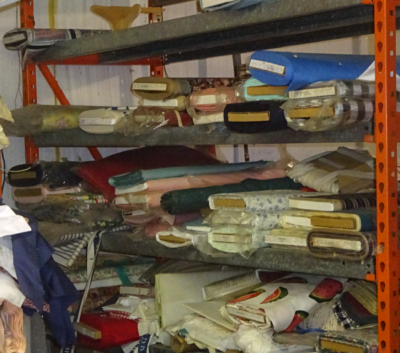 Bolts and bolts of cloth – being put to good use. It began with a comment from a friend who knew that we had a lot of cotton cloth – and a number of different sewing machines in the basement.
Why don’t you make masks and give them away?
So we did.
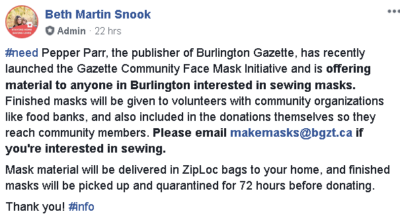 We reached out to Burlington CareMongers and asked if there were people who could make masks if the cloth was provided. We had ten positive responses before the day was out. We reached out to Burlington CareMongers and asked if there were people who could make masks if the cloth was provided. We had ten positive responses before the day was out.
It just built from there.
What kind of masks: the tie type of masks or with elastic?
Many people said elastic could get quite uncomfortable – so we opted for tie type masks.
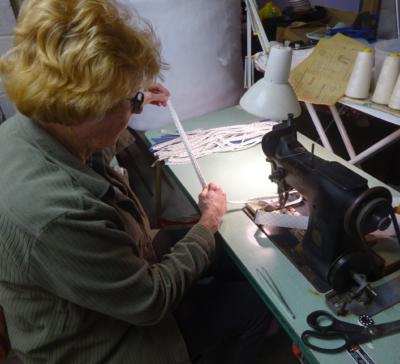 Four ties per mask – 2000 masks – you do the math. That meant we also had to make the ties.
We decided that we would make the ties and pass those along with the cloth and have the sewers do the assembly.
Someone had to do the organizing.
That’s when Connie Price came through – Big Time. She has undertaken the supervising of the sewers – getting material to them and following their output.
We then had to get the completed product from the mask makers. The Burlington Kinsman stood up and took on that task.
They will pick up the completed product, quarantine the bags for 72 hours and then deliver it to the people who will hand it out to the public.
The Burlington Community Seniors put up a bit of cash to cover the small expenses.
Then there has to be a location where the completed masks could be delivered; then inspected, then placed in plain brown envelopes and quarantined for 72 hours then handed over to the Burlington Lions Club who will deliver the ready to use masks to the organizations that were going to do the final distribution.
 First batch of the masks being given out at St Matthews Anglican Church The was like creating, instructing and communicating with a small army.
So far it is working.
The first batch of 100 masks was delivered to Connie Price a few days ago. She is handing them out to people who drop off food at St Matthews Anglican Church. Part of that first shipment went to the Food Bank.
Councillor Stolte (ward 4) is working with the Caremongers to find volunteer sewers who are perhaps not on Facebook.

 By Pepper Parr By Pepper Parr
April 28th, 2020
BURLINGTON, ON
This could be fun – and goodness knows we need something other than black humour.
 Never quite sure what Lisa Kearns is going to say when she has a microphone in her hands. Lisa Kearns, Councillor for Ward 2, has announced that she is going to hold a virtual constituency meeting.
In a message to everyone on her mailing list she said:
You’re invited to a Ward 2 Virtual Community Update Meeting on Thursday, April 30th, 2020 from 7 p.m. to 8 p.m.
The best place for you is at home, please join me through Zoom technology (video and/or audio) to connect with the community.
Hear about what’s happening at City Hall and in your City. Engage on what matters to you.
• CoVID-19 Response
• City Hall News
• Planning & Development
• Construction & Projects
• Healthy Living
• Environment
• Q&A Session
As always, everyone welcome.
Kearns is what we journalists call “good copy” – you’re never sure what she is going to say or how the words are going to flow from her mouth.
The best I ever got from covering her events was that “Phoney baloney” line.
So tune in on Thursday – it might be better than the movies – and given that the theatres are closed, Lisa Kearns is all you have going for you Thursday night.
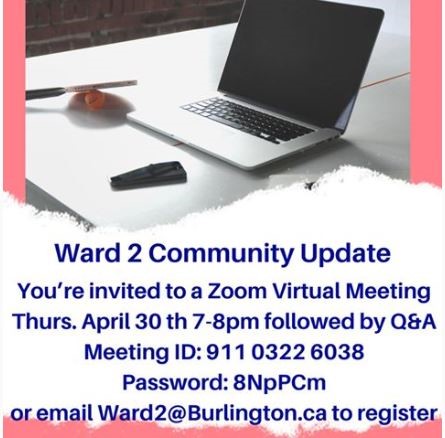

 By Pepper Parr By Pepper Parr
April 28th, 2020
BURLINGTON, ON
Ashley Worobec is a self-described Type-A personality.
She runs. A typical day is up at 5:00 am and out running 5km with her dog.
Career wise she is a chiropractor working at a sports clinic.
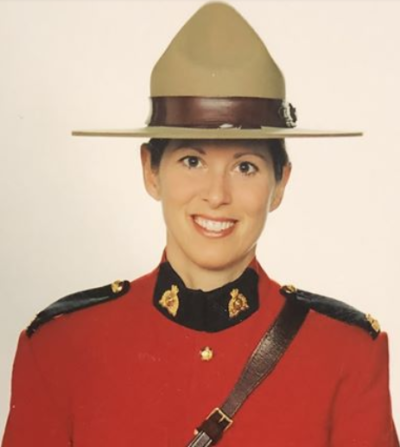 RCMP Constable Heidi Stevenson, mother of two children killed by a shooter evading police to be honoured by people doing a 10 minute workout every Friday. The tragedy in Nova Scotia last week moved her to use her workout skills and develop a short program to honour the memory of RCMP Constable Heidi Stevenson.
The initiative she has just begun is hosting “Movement You”, which is a 10-minute workout, LIVE online on her Facebook and Instagram pages (search “Dr. Ashley Worobec”)-“ it’s a way for me to connect with my community and to encourage my patients to stay active and moving, which is something I believe passionately in”, said Worobec.
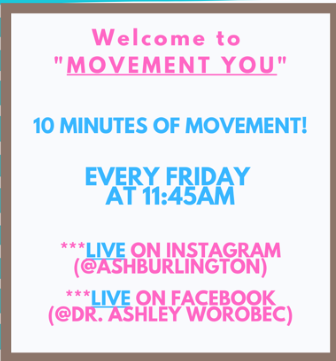 “Last Friday was the first time doing this, and it was a wild success, with my kids participating in the workout too. I plan on making this a weekly thing, every Friday at 11:45am, with movements that people can do easily in their living rooms. “Last Friday was the first time doing this, and it was a wild success, with my kids participating in the workout too. I plan on making this a weekly thing, every Friday at 11:45am, with movements that people can do easily in their living rooms.

 By Staff By Staff
April 28th, 2020
BURLINGTON, ON
Some people are not staying at home.
The Halton Regional Police Fraud Unit has made arrests related to an investigation into an organized automotive fraud ring. To date, police have arrested and charged two individuals, and seized 17 vehicles valued at approximately $1.35 million dollars.
 Obtained through fraud – driven to Montreal, loaded into a container and taken to the Middle East – but not this time Officers began the investigation in January 2020 after two pickup trucks were fraudulently obtained from a dealership in Oakville. Through further investigation, officers learned multiple vehicles were being fraudulently obtained by the suspects, who then attempted to ship them out of Canada via the Port of Montreal to the Middle East and Eastern Europe. With the assistance of the CBSA the vehicles were seized prior to leaving Canada.
 A brand new Dodge Ram – headed for the Middle East – obtained fraudulently The vehicles were purchased from various dealerships in the GTA, including a local dealership in Halton (Oakville).
Search warrants have been executed at three separate locations in Mississauga. During the course of the investigation police have seized the previously mentioned vehicles , electronics, and $4700 in Canadian currency.
Arrested and charged:
Muhammed Khoshnaw (59) of Mississauga
o Fraud over $5,000 (x2)
o Possession of property obtained by crime
Mohammed Hussein (29) of Mississauga
o Possession of property obtained by crime (x4)
This investigation is ongoing and more arrests and charges are expected.
“The detection and disruption of organized crime groups such as this one is an ongoing priority of the Halton Regional Police Service. The negative impact on the community from fraudulent criminal activity is significant and takes the form of increased insurance and retail costs,” says Deputy Chief Jeff Hill. “I would like to commend our Regional Fraud Unit and the Canada Border Security Agency on the success of this investigation.”
Anybody who may have additional information pertaining to this incident is asked to contact the Regional Fraud Unit at 905-825-4747 ext. 8738.
Tips can also be submitted to Crime Stoppers “See something? Hear something? Know something? Contact Crime Stoppers” at 1-800-222-8477 (TIPS) or through the web at www.haltoncrimestoppers.ca.

 By Staff By Staff
April 28th, 2020
BURLINGTON, ON
Yesterday morning Premier Doug Ford set out what he called a Roadmap to get the Ontario economy back to how it traditionally operates.
This morning Mayor Meed Ward had the following comments on the position the Premier took.
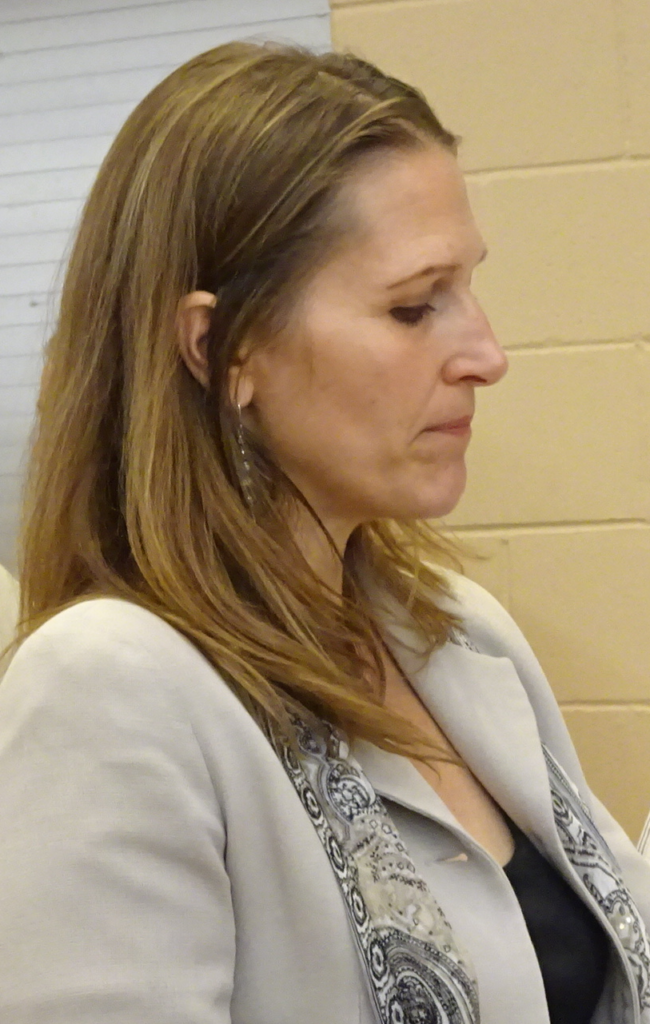 Mayor Marianne Meed Ward Yesterday Premier Ford and his team announced a road map to begin reopening Ontario with a focus on protection, reopening, and recovery. This is welcomed news for all Ontarians and a direct result of the hard work and sacrifices everyone has made to help successfully flatten the curve of COVID-19.
The City of Burlington is looking forward to implementing a similarly phased approach that aligns with the framework and guidelines being followed at the provincial level. This roadmap is about the how more than the when.
Ontario’s Chief Officer of Health has outlined three stages for opening workplaces and public spaces and permitting gatherings as time progresses. The criteria the Province will be using in their decision-making include:
• A consistent two-to-four week sustained decrease in the number of new daily COVID-19 cases;
• Sufficient acute and critical care capacity, including access to ventilators and ongoing availability of personal protective equipment (PPE);
• Approximately 90 per cent of new COVID-19 contacts are being reached by local public health officials within one day, with guidance and direction to contain community spread; and
• Ongoing testing of suspected COVID-19 cases, especially of vulnerable populations, to detect new outbreaks quickly
The federal government also indicated yesterday that reopening guidelines should include the capacity for testing, an adequate supply of PPE in place, and the continued medical capacity in place to handle a surge.
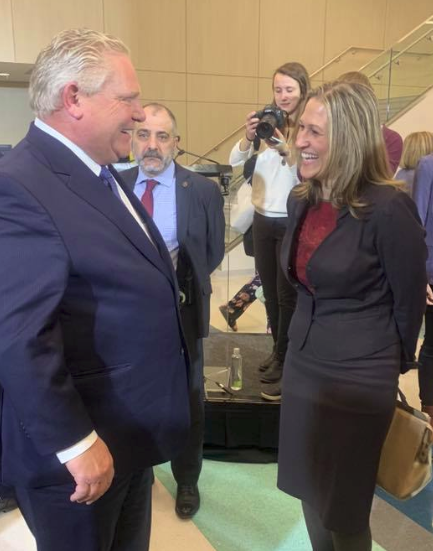 Mayor Marianne Meed Ward meets with Premier Doug Ford at a Joseph Brant hospital event While no specific dates have yet been announced by the Province in their detailed framework, we know that with the closure of schools and provincial parks being extended to May 31st we have a slow and steady timeline ahead of us. City Hall and city facilities will remain closed through the end of June as previously announced. Burlington’s local businesses launched a campaign yesterday encouraging our community to continue to “Stay home so Burlington can get back to business”. In alignment with the Province and their future decisions related to lifting restrictions on essential services impacting the City, we will not rush this recovery at the expense of the progress we have made thus far.
Our number one priority in Burlington continues to be the health and well-being of our people, especially those who are most vulnerable.
As we formalize our plan with input from city leadership teams and council in May, we will partner closely with Halton Region Public Health so we can continue to closely monitor the level of risk being posed by COVID-19 throughout every stage of our plan.
Halton Region’s mayors, including Mayor Rick Bonnette, Mayor Gordon Krantz, Mayor Rob Burton and myself, have formed a partnership to work together on our respective plans. All four mayors have come together as the Halton Mayors Recovery Coordination Group and made the commitment to keep each other and Halton Region Chair Gary Carr apprised of decisions being considered in each municipality, share best practices, and coordinate our plans and timing.
In the weeks and months ahead, our commitment as a City is to be crystal clear and transparent about the plans and specific behaviours we are asking of the public, keep the community informed of evolving risks, and work diligently with our healthcare partners to track infection and continue to mitigate the spread of COVID-19.
We have all made many sacrifices to flatten the curve here in Burlington and we must ensure they were not made in vain. For now, we must continue to stay home and follow the advice of health experts while we navigate this virus and plan the way forward. We will be cautious and careful in each step we take so that we can safely reopen our economy, manage risk, and keep our community healthy.
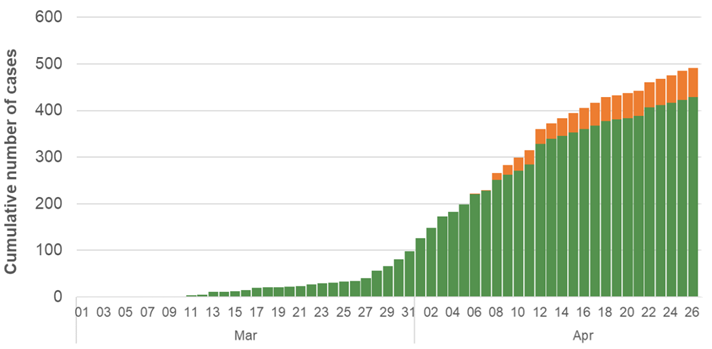 The curve for the Region of Halton is far from flattening.


By Staff
April 28th, 2020
BURLINGTON, ON
The summer is beginning to look quite quiet; the Burlington Downtown Car Show has been cancelled.
 Remembering when Ron Baker, organizer and promoter of the event announced today that “Due to the Covid-19 pandemic and the uncertainty of protocol for social distancing in early July, the Burlington Downtown Car Show is cancelled for this year.
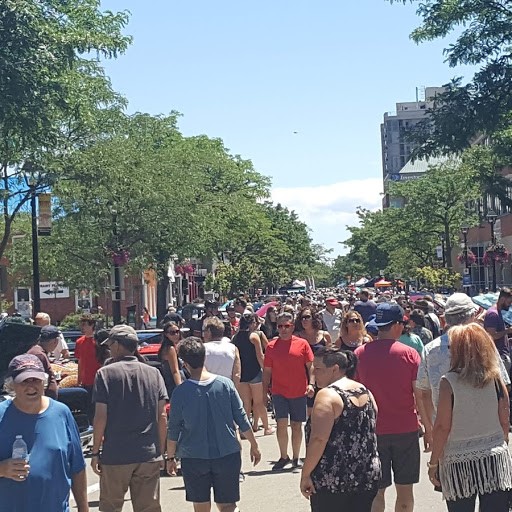 Best argument ever for making Brant a pedestrian only street – car show crowd filled the street ‘The Car Show has become a mainstay of summer in the city. Five hundred meters of Brant Street in downtown Burlington is turned into a pedestrian mall with as many as 200 cars on display.
“The idea has always been to present a celebration of the automobile”, stated Ron Baker, car show founder. “We have had representation of every decade of the automobile on display, from 1910 to present day”. The show has attracted over 100,000 visitors in the past five years.
The summer of 2021 is an option.

 By Nicki St George By Nicki St George
April 28th, 2020
BURLINGTON, ON
Nicki St George is the mother of two, lives in Aldershot and teaches at a private school in Oakville. She is also a recovering cancer patient.
WEEK 6 – seriously?
As the days are becoming indistinguishable from one another, here are some ups and downs during my time in self-isolation:
The UPS:
• When a box is delivered, and you cannot remember what it could be because you have ordered so much crap over the last 6 weeks.
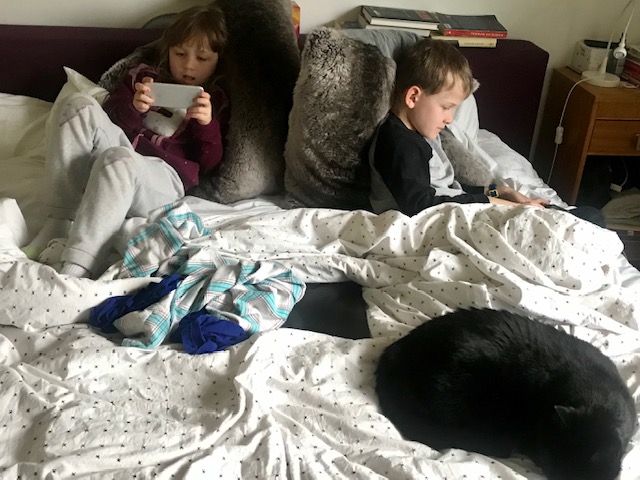 Clifford the cat and the kids – in their parents bed. • Clifford the cat – my self-isolation guru.
• When the makers of Candy Crush give the gift of unlimited lives for a whole week!
• Having the time to make homemade hamburger buns and other treats.
• Puzzles – Now that everyone is into doing puzzles, I do not feel like quite as big a nerd.
• No sport on TV = nothing left for my husband and I to fight about.
• Learning a new language while binge watching Money Heist.
• Saying goodbye on Zoom or Houseparty…you just hang up! No more awkward goodbyes at the door.
• Saving money on car insurance because you are no longer driving to work every day.
• Bringing out the patio furniture and setting up the trampoline. It’s starting to feel a little like summer.
• Less laundry…just choose your legging/sweat top combo for the week and you’re good to go.
• The magical hour around 5pm every day when a glass of wine and favourite song provide me with the motivation to dance and cook dinner.
• Discovering a new podcast.
The DOWNS:
• Temperatures in the single digits in April…or worse, snow!
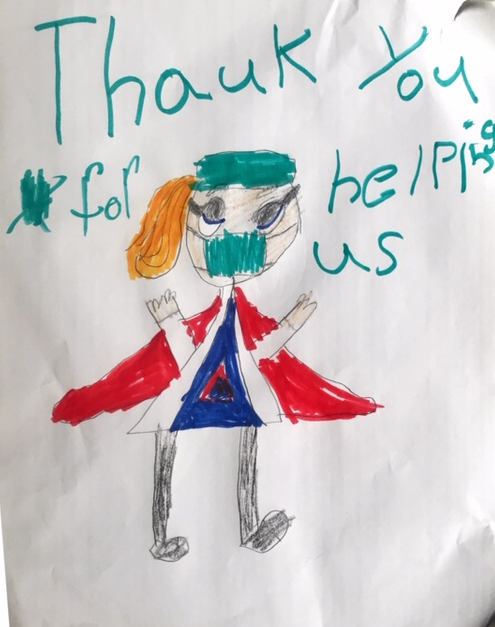 Results of a parent led art class • The annoying soundtrack of Beatrix’s YouTube videos which have become ambient noise in the house.
• My embarrassingly high score on Candy Crush.
• Where do all the charging cables keep disappearing to?
• Making plans for the summer…
• Google classroom on the iPad: why can’t I just write on the document?
• Sad husband because there is no sport on TV.
• Finding out that schools will remain closed until at least May 31st – SERENITY NOW!
• Doing your tax return – the worst part of being an adult.
• Getting the weekly alert telling me what the average daily screen time was last week…gulp.
• The absurd volume of new passwords to remember for accessing homeschool websites.
• Deciding what PPE to don on the weekly trip to the grocery store – how many times can I reuse this same mask?
• At home haircuts…they’re not everyone’s cup of tea.
• Finding the motivation to do at home workouts and complete assignments for grad school.
• Being interrupted by children asking for TV during a work Zoom call -this was not on the list of pre-approved activities.
• Google Play charging $19.95 to RENT Trolls 2 – how dare they?
• Discarded latex gloves left on the ground: so uncool.
Previous columns:
The idea
Week 1
Week 2
Week 3
Week 5

 By Staff By Staff
April 27th, 2020
BURLINGTON, ON
In her A Better Burlington newsletter, Mayor Marianne Meed Ward said:
Our community has received some great and long awaited news today from Steve Clark, Minister of Municipal Affairs and Housing, and Caroline Mulroney, Minister of Transportation: the city and Region can immediately work together to remove the Major Transit Station Area (MTSA) and Mobility Hub designations downtown.
These designations have been used to justify overdevelopment in downtown Burlington.
In a letter addressed to myself as head of Burlington City Council and Gary Carr, Chair of Halton Region Council, the Minister states:
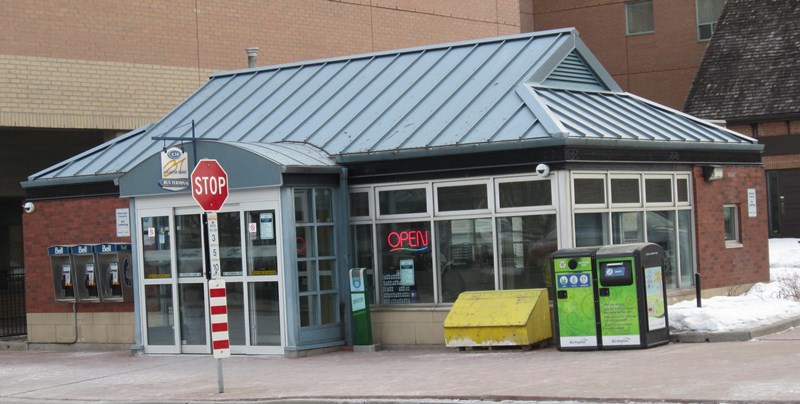 There was a point at which a former Director of Transit suggested tearing the building down. Then it became a technical point on which a developer won the right to put up a 24 story building. “There is no provincial requirement for mobility hubs to be identified in municipal official plans, including Downtown Burlington…. Therefore, the Region of Halton, working with the City of Burlington, has the ability to remove the identification of a mobility hub and an MTSA in Downtown Burlington, centred on the John Street bus terminal, from its Official Plan.”
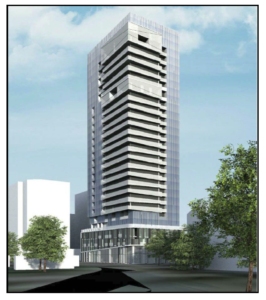 The developers of the Naurique will always have a soft spot for that little transit station. The letter further states that the change can be made through an Official Plan Amendment now, or during the next Municipal Comprehensive Review, scheduled at the Region for later this year.
“This means that the Region can submit an amendment to remove the Downtown Burlington mobility hub and MTSA designations in the Region of Halton’s Official Plan now.”
The mobility hub designation for downtown Burlington and the Burlington GO station first appeared in Metrolinx documents in 2008, and was later embedded into the Region of Halton Official Plan in 2011, based on the 2008 Regional Transportation Plan.
The 2041 Regional Transportation Plan, issued in 2018, refined the concept of mobility hubs to focus on MTSAs along subway lines and priority transit corridors.
As a result of changes to the policy framework for planning in the Greater Golden Horseshoe introduced by the current government “we do not require mobility hubs to be identified in municipal official plans.”
The ministers have also directed Metrolinx “to remove legacy documents that refer to the 2008 mobility hubs.”
Both ministers also specifically thanked our Burlington Member of Provincial Parliament Jane McKenna for her “tireless advocacy” on behalf of residents to remove the MTSA/Mobility Hub.
“As a result of extensive advocacy from MPP Jane McKenna since July 2018 we agree that the John Street bus terminal does not constitute a mobility hub given that it is not at the intersection of multiple Frequent Rapid Transit Network routes.”
City and Region planning staff are reviewing the letter and will have more information for the community on next steps and timing in coming days.
With news like that in the air it didn’t take MPP Jane McKenna long to get a place in that parade. In a media release from the Office of the MPP, the first the Gazette has received in over a year, McKenna said: ““I’m happy to report today that there is no longer a provincial requirement for the mobility hub or Major Transit Station Area designation in Downtown Burlington,” said MPP Jane McKenna.
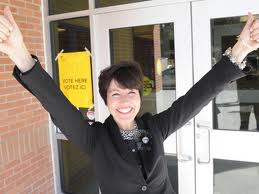 Jane McKenna the night she was elected the first time “This means that Halton Region, working with the City of Burlington, can submit an amendment to the province now to remove Burlington’s downtown mobility hub and MTSA designation from the Region’s Official Plan.”
“The Ford government has taken the position that municipalities may choose to take a phased approach to their municipal comprehensive review through multiple municipal official plan amendments under section 26,” said Minister Steve Clark. “As a result, removing the MTSA designation from Downtown Burlington could occur through a municipal official plan amendment under section 17 of the Planning Act.”

 By Pepper Parr By Pepper Parr
April 27th, 2020
BURLINGTON, ON
Ward 5 Councillor Paul Sharman weighs in on what happened to that development on Brant Street.
On August 31, 2017, the Planning and Building Department acknowledged that a complete application had been received for an Official Plan and Zoning By-law Amendment for 2100 Brant Street to facilitate the development of 233 townhouse units.
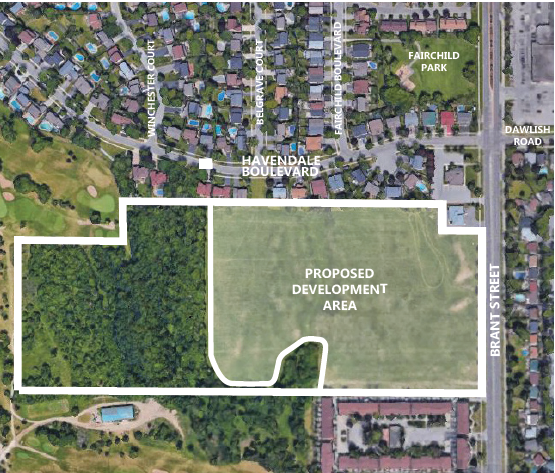 The ward Councillors; first Rick Craven and now Kelvin Galbraith were not opposed to the development. The original applications proposed the development of 233 townhouse dwelling units comprised of street townhouses located along Brant Street and a proposed public street and standard condominium townhouse units. The original net density of the development was 43.55 units per hectare and gross density was 21.07 units per hectare. The applications were requesting site specific exceptions to allow for the development.
Further to technical comments received from staff, other agencies and public feedback received through the processing of the applications, the applicant made changes to the proposed development and submitted revised studies, reports and a reconfigured draft plan of subdivision.
The applicants appealed the subject applications to the Local Planning Appeals Tribunal after the required time period established by the Planning Act expired. Notwithstanding the appeals, the City continued to work with the applicant in an effort to resolve what the City and its residents were concerned about. The result of these negotiations with the applicants, was Minutes of Settlement. This agreement was reached in November 2018 and supported a 212-unit townhouse development. This settlement agreement was based on the assessment from staff that the application satisfied all regulatory and planning requirements and was therefore defensible at LPAT.
 Paul Sharman listening to a delegation Despite the advice of staff, on December 17, 2018, the newly elected City Council, in a vote that was not unanimous, repudiated (i.e. cancelled) the settlement agreement. That decision not only pushed the City and the applicants towards an LPAT hearing but is also expected to lead to an awarding of costs to National Homes in an amount of approximately of $28,000 when the final settlements and awards are confirmed.
Notwithstanding the grim reality facing Council, City staff continued to work with the applicant in an effort to further refine the proposal to address concerns raised by members of Council and the neighbourhood surrounding the property.
At its meeting of April, 20, 2020 Burlington City Council approved the planning staff recommendation of Confidential Legal Report L-10-20 to accept a new offer of settlement between National Homes (Brant) Inc. (“National Homes”) and the City.
This settlement agreement presented to us was essentially based on the assessment from staff indicating that proposed amendments to the development proposal satisfied all regulatory and planning requirements and was therefore defensible at LPAT. The settlement proposed is almost identical to the rationale provided to the previous Council.
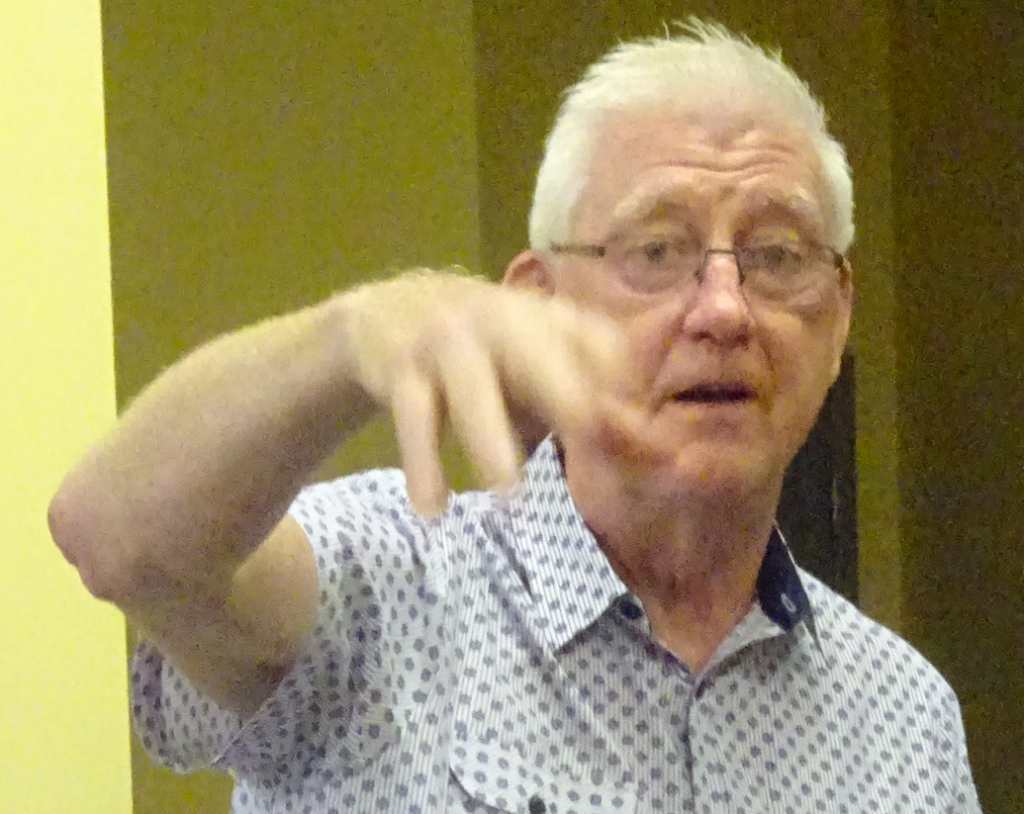 Paul Sharman fighting for his political life in the fall of 2018 Sharman says he is “the only returning member of Council in 2018 who voted to support of the original settlement agreement with National Homes. That decision was based on two considerations.
The first being that the applicant had worked with community members and staff to achieve several modifications. Original 2018 approved settlement included:
• reduction of 21 units
• addition of 0.76 parkland
• addition of 7 townhomes suitable for families and seniors
The second consideration being the assessment of staff that the application satisfied all regulatory and planning requirements and was therefore defensible at LPAT.
“On April 20th, 2020, I again voted in support of what was essentially the same application that I supported in 2018, for the same reasons although, as I have noted, there were some further, minor, modifications.
“Ironically, it is possible that increased setbacks included in the 2020 settlement will actually increase the net density of the development. In other words, the development will be more compact.
“It is unfortunate that taxpayers will likely foot a $28,000 legal fee that will be awarded against the City resulting from the new 2018 Council decision to scrap the first settlement agreement.”
Is that a shot over somebody’s bow?
Related articles:
John Calvert’s J’Accuse
The Mayor’s rationale

 By Pepper Parr By Pepper Parr
April 27th, 2020
BURLINGTON, ON
It does sound a little ass-backwards – but they are on the right path.
The hospitality and entertainment sectors are hurting – they are bleeding.
With the weather beginning to look nice the idea of being on a patio in the afternoon when the work is done sounds very inviting.
Team Burlington gets it – not yet – but soon IF you stay home so that they can eventually get back into business.
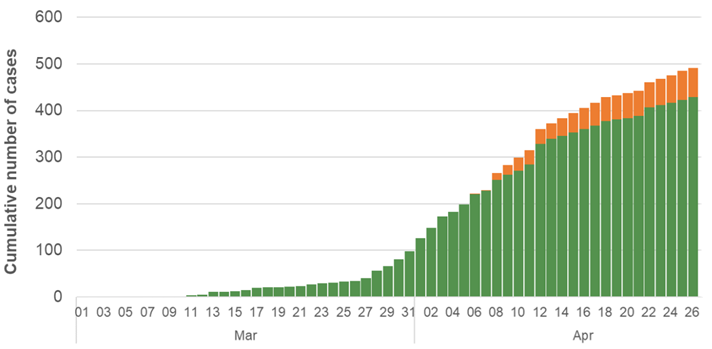 The curve is far from flat. The virus that is infecting people is being passed from person to person – not from someone from China. They are calling this initiative their STAY HOME to Get Back to Business campaign – they are encouraging people to support local business by staying home and practicing physical distancing which will ultimately help businesses open their doors sooner.
It isn’t just the hardest hit industries that are feeling the impacts of the global pandemic. Businesses of all sizes and across all industries are experiencing unprecedented challenges, including significant and unforeseen revenue loss, the need to lay off staff, supply chain disruptions, and uncertainty about the future of their business and when they will be able to reopen. Simultaneously, businesses are also facing tremendous pressure to digitize and shift existing business models to include online and contactless pick-up and delivery options.
Team Burlington recognizes these challenges and plans to leverage their audience and networks to help get Burlington businesses open as soon as possible. The STAY HOME(to Get Back to Business) campaign reinforces the message that is consistent with public health officials — the sooner people STAY HOME, the sooner the business community can open their doors and get back to business.
 Brian Dean, Executive Director of Burlington Downtown Business Association “Businesses of all sizes are being impacted by COVID-19″ said Brian Dean, Executive Director of Burlington Downtown Business Association, one of Burlington’s two Business Improvement Areas (the other being Aldershot Village BIA). “We hope this campaign will help Burlington residents understand that their actions and choices during this time have direct consequences on our business community.
We are getting asked a lot about how people can support their local businesses. One of the things you can do is stay home and practice physical distancing as much as possible.”
Craig Kowalchuk, Owner of Emma’s Back Porch and the Water Street Cooker and President of the Burlington Restaurant Association echoed Brian’s sentiment. “Temporarily laying off staff and closing down the restaurant has been one of the most difficult things I’ve had to do in my twenty-eight years of operations.” He went on, “You can help us get back to business by staying home, reduce your trips to the store and minimize contact with others. We can’t wait to welcome you back, for our twenty-ninth summer, but we can’t do that until everyone stays home.”
The STAY HOME campaign will be launched across social media, as well as through window decals displayed in the windows of downtown businesses. A video campaign featuring local business owners from across Burlington will also help spread the message.
Give Team Burlington credit for doing the right thing, the responsible thing. And remember all this when they are able to open their doors again.

 By Pepper Parr By Pepper Parr
April 27th, 2020
BURLINGTON, ON

We asked the two women who are providing Gazette readers with an ongoing commentary on how things are going in their households with the schools being closed. The province’s decision to keep the schools closed until the end of May might create situations that will be difficult for many parents.
Ashley Worobec, the Chiropractor who runs long distances when she can find the time, said she “didn’t have much to say – It really doesn’t change anything for us- we were expecting the date to be delayed, which it has been, and we’re prepping ourselves mentally for the possibility that the next extension will end the school year entirely.
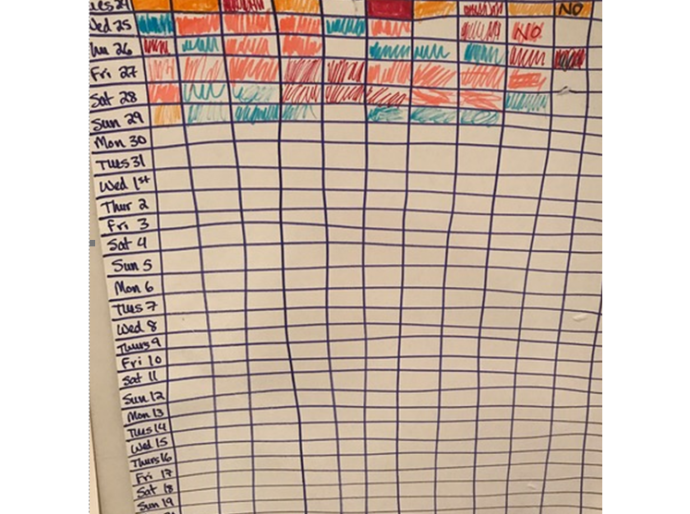 The Worobec family created a mammoth Task list to give the new approach to education some structure. “I do like how they’ve decided to watch and wait instead of just cancelling the school year entirely like some other provinces have, as that’s given us hope instead of looking ahead to months and months without school. At least this way, there’s still a glimmer of hope.”
Ashley’s two children seem to be coping quite well – the task list picture tells part of the story for their household.
Nicki St George said she “finds it frustrating to be stuck at home while the school closure date keeps getting pushed back further and further. It only serves to foster more uncertainty for myself and the kids. We are fortunate to have the time and technology available to facilitate learning from home but many people do not.
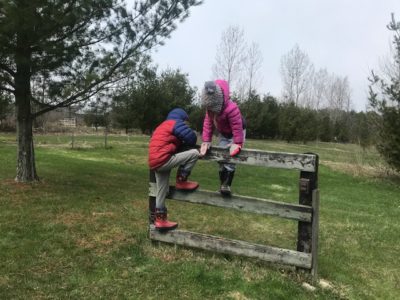 Getting them outdoors where they can burn off some of that energy. “Considering the preliminary data which suggests that school closures will have little impact on the spread of the virus, I think that the harms of keeping schools closed (specifically elementary schools) will likely outweigh the benefits.”
Mixed views.
One of the major issues during the months of short term school strikes was the number of On-line courses students were going to be required to take – with the strikes now settled teachers find themselves delivering every hour of instruction on-line.
Something ironic about how that turned out – teachers will get to learn that some courses can be done very well on-line and some parents might come to the realization that on-line instruction can be very effective in some situations.
The school boards take direction from the province. However, the school boards are the people that are going to have to deal with the disruption in the delivery of an education. They also have to look at the impact of the disruption on the quality of the education they deliver.
Moving from the end of elementary school and on into high school is a major right of passage for students. But what if high school starts with an hour in front of a computer monitor?
That’s an issue that senior school board staff find themselves thinking about.

 By Staff By Staff
April 27th, 2020
BURLINGTON, ON
While we are not yet out of the woods – not by any stretch of the imagination, all four Mayors in Halton Region, Burlington, Halton Hills, Milton and Oakville have formed the Halton Mayors Recovery Coordination Group
The four Mayors, Burlington Mayor Marianne Meed Ward, Halton Hills Mayor Rick Bonnette, Milton Mayor Gord Krantz and Oakville Mayor Rob Burton will coordinate and work together to prepare for a successful transition to a post COVID-19 emergency, reopening and recovery, and living with the changes it has brought.
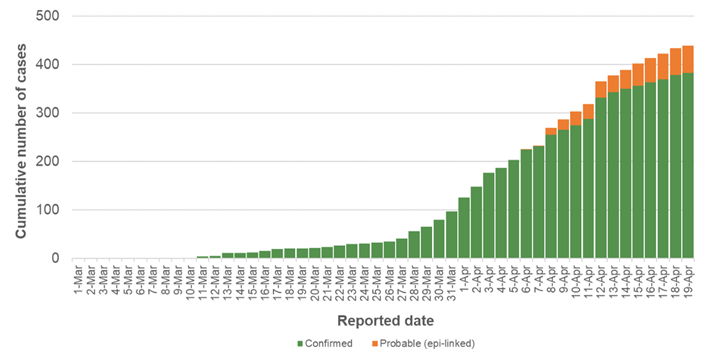 This curve has not flattened – the focus should be on getting the curve to change direction – creating a Group to Plan for a Recovery looks like a chance for a photo-op. While this does not mean that emergency measures put in place by the province, the region or individual cities and towns to slow the spread of COVID-19 are expected to be lifted in the near-term, it is prudent to begin to look ahead so that our plans can be ready to execute when the time comes.
The final phases of the pandemic response include the potential reopening of municipal facilities and the implementation of recovery efforts over the balance of the year. The dates of when recovery might begin are contingent on the continued slowing of the spread of the virus and the province lifting its emergency orders and restrictions, including those related to businesses and physical distancing.
“From the beginning of the COVID-19 crisis, we have stayed in contact as we collectively responded to the situation at hand, so it makes sense that we remain aligned as we plan for the post-COVID-19 recovery phase in our communities,” said Mayor Marianne Meed Ward.
 “All four Mayors have made the commitment to keep each other apprised of decisions being considered in each respective municipality, share best practices, and coordinate when it comes to the recovery planning. They will also ensure a continued close linkage with Halton Region, with the chair Gary Carr as an invited guest to our group when his schedule permits.” “All four Mayors have made the commitment to keep each other apprised of decisions being considered in each respective municipality, share best practices, and coordinate when it comes to the recovery planning. They will also ensure a continued close linkage with Halton Region, with the chair Gary Carr as an invited guest to our group when his schedule permits.”
__

 By Pepper Parr By Pepper Parr
April 27th, 2020
BURLINGTON, ON
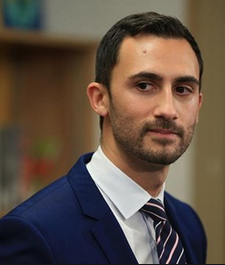 Education Minister Stephen Lecce Education Minister Stephen Lecce announced on the weekend that all publicly-funded schools will remain closed until at least May 31, 2020, as part of an effort to keep students, staff and families safe from COVID-19.
The extension was based on expert advice from the Chief Medical Officer of Health and health officials on the COVID-19 Command Table and is part of the government’s ongoing effort to stop the spread of the virus. The advice was to extend school closures for an additional period of time to permit updated modelling and data to inform next steps, given the government’s absolute commitment to safety.
“We will do whatever it takes to keep our students safe,” said Minister Lecce. “The government is taking a careful approach which provides our medical experts the time to review the modelling and make the best decision for the safety of our students and the future of learning.”
The government took immediate action to close schools in Ontario, the first in Canada to do so. The ministry continues to monitor the evolving situation and if necessary, the closure may be extended further to protect the health and safety of Ontario’s school communities.
At the same time the Ontario government is taking steps to ensure learning can continue. In March the province unveiled its Learn at Home portal. It offers all students high-quality resources, featuring made-in-Ontario math and literacy resources, created by Ontario-certified educators, in both English and French. Elementary resources are designed to help young students learn at home with interactive activities that encourage participation through entertaining and stimulating digital content. High school content was designed with a focus on STEM courses and ensures core competencies and skills are reinforced.
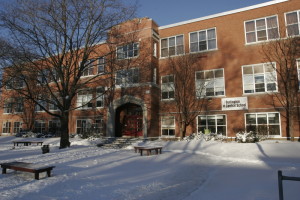 There won’t be a graduation ceremony and no prom either – but depend on the students to come up with something to celebrate leaving high school. “Regardless of what transpires over the coming weeks, Ontario’s students will be able to complete their school year with confidence,” added Minister Lecce. “In particular, for students in their final year, we are removing all impediments to ensure students graduate and pursue post-secondary education.”
In the event that they do reopen, school employees will have access as of May 29, 2020.
The Ministry of Education will move forward to replace the remainder of Professional Activity (PA) days and examination days with instructional time, as well as the introduction of an expanded summer learning program that will focus on credit recovery, supports for vulnerable students, and course upgrading. Boards are to find solutions at the local level in keeping with this direction while upholding collective agreement obligations.
The Minister of Education later said that the next time he makes a public announcement it will be to set out how the balance of the school year will be dealt with.
Later today Premier Doug Ford will unveil the framework for re-opening the province.

 By Staff By Staff
April 25th, 2020
BURLINGTON, ON
Getting into spring and thinking about summer is going to be harder this year than it was last.
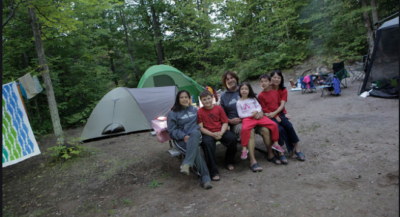 No camping in provincial parks – Maybe in June? The province announced on Friday that the government is extending the closure of Ontario’s provincial parks and conservation reserves to May 31, 2020.
This includes car camping, backcountry camping, roofed accommodations, day use opportunities, access points and all public buildings.
Provincial parks and conservation reserves will continue to remain fully closed to all recreational activities.
Reservations for arrivals up to, and including, any further closure extension date will be automatically cancelled and reservation holders will receive a full refund with no penalty. We are also providing penalty-free refunds to reservation holders who wish to change or cancel their 2020 camping reservation, regardless of arrival date.
This is part of the drive to keep us apart and not have groups of more than five people congregating in one place.
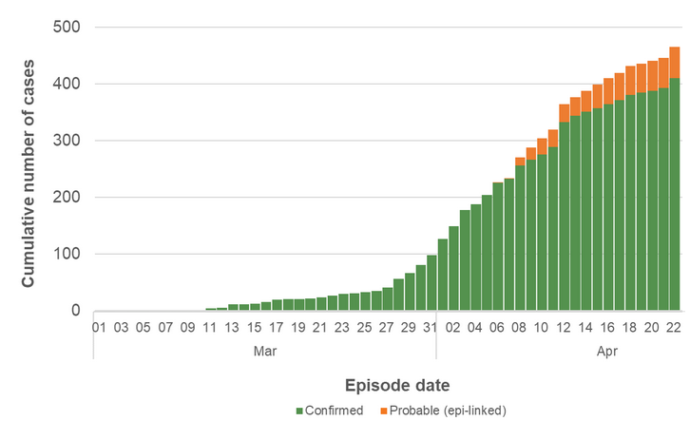 This is the infection curve for Halton – it hasn’t begun to flatten yet. That curve of COVID-19 infections is not flat enough – this kind of direction is going to be necessary until the number of infections stop increasing.
The virus that is now loose in the community is being passed from person to person – we know that. What we don’t know is who has it and who are they passing it to.

 By Pepper Parr By Pepper Parr
April 25th, 2020
BURLINGTON, ON
The Halton Region Public Health unit produces data on the status of the COVID-19 infection and the rate at which infections have grown and the number of people believed to have died as a result of the virus.
Cases over time
466 COVID-19 cases among Halton residents to date (410 confirmed + 56 probable)
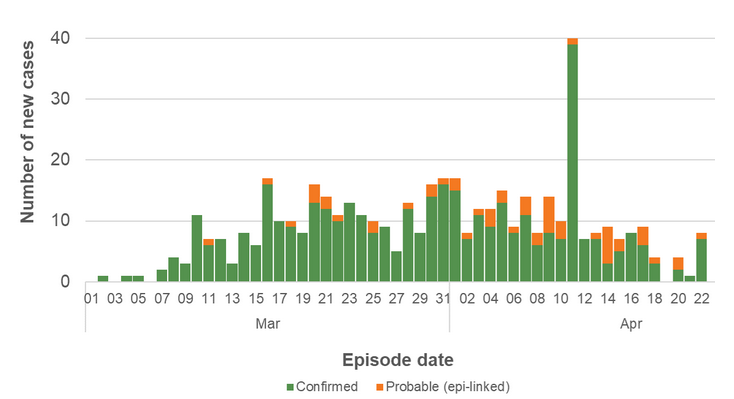 Figure 1: COVID-19 cases, by episode date, Halton Region, Mar. 1-Apr. 22, 2020 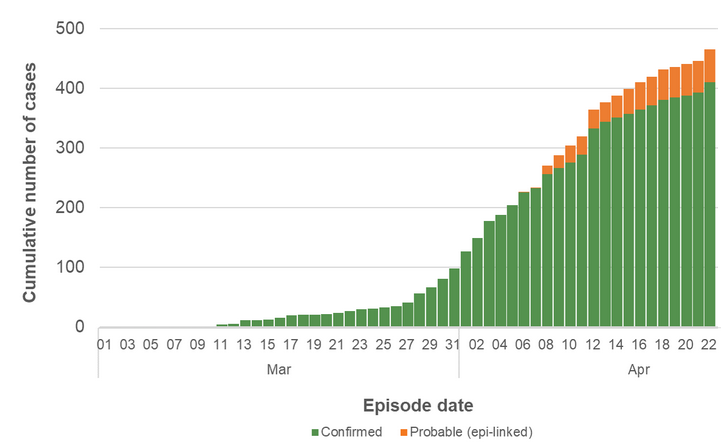 Cumulative COVID-19 cases, by episode date, Halton Region, Mar. 1-Apr. 22, 2020 Figures 1 and 2 show the 466 COVID-19 cases among Halton residents reported by end of the day on April 22. Unlike past reports, all cases have now been graphed according to their episode date, which is used to estimate the date that symptoms began. Figure 1 shows the number of new cases per day, while Figure 2 shows how cases have accumulated over time. Counts for the past 14 days should be interpreted with caution, since there is a delay between when a person becomes infected and when they develop symptoms, get tested, and are reported as a case. Please note the large increase on April 11 is due to expanded testing and identification of COVID-19 among asymptomatic individuals at Mountainview Residence.
Individuals who are lab-confirmed cases are shown in green. Individuals who are probable cases are shown in orange. Probable cases are epi-linked cases, which means they are presumed to have COVID-19 because they are symptomatic close contacts of cases or returning travelers who have COVID-19 symptoms.
Case demographics
70 cases were residents or patients of an institution experiencing an outbreak (15% of all cases)
64 cases work in health care (14% of all cases)
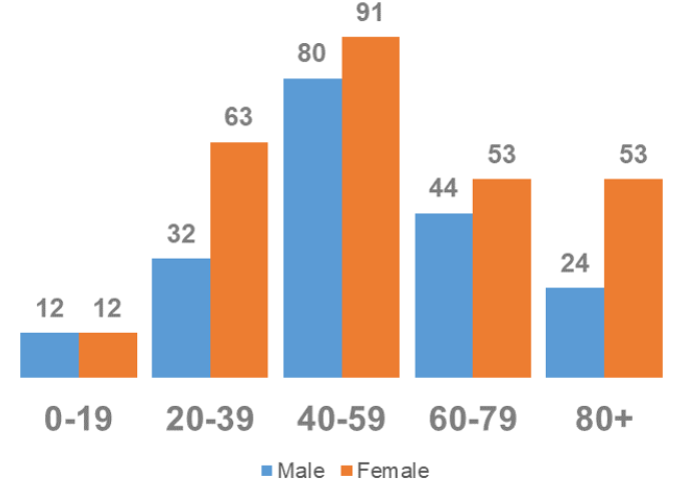 Figure 3: COVID-19 cases, by age and sex, Halton Region, 2020 Figure 3 shows that by end of the day on April 22, the most COVID-19 cases were among Halton residents aged 40-59 (with 171 cases, or 37%). 272 cases (59%) were female. Please note this figure excludes two cases with sex information pending.
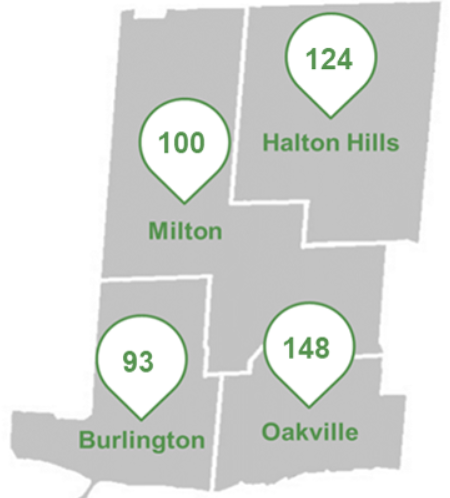 Figure 4: COVID-19 cases, by municipality of residence, Halton Region, 2020 Figure 4 shows that by end of the day on April 22, the greatest number of COVID-19 cases were among residents of Oakville (with 148 cases, or 32%). Please note this figure shows counts, and therefore does not take into account the different population sizes or age structures of the four municipalities. Counts in municipalities can also be inflated by outbreaks that have occurred within institutions in their boundaries. The figure excludes one case with municipality information pending.
Case exposure source
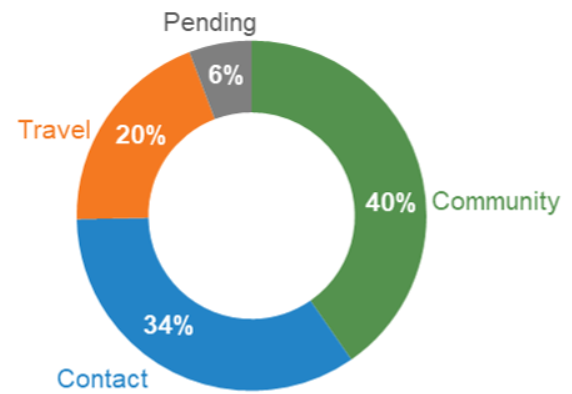 Figure 5: Percentage of COVID-19 cases, by exposure source, Halton Region, 2020 Figure 5 shows that by end of the day on April 22, 188 of Halton Region’s COVID-19 cases (40%) had no known travel or contact history, and therefore were believed to have acquired the virus within Ontario, making them community cases. 160 cases (34%) had contact with a confirmed case that was believed to be the source of their infection. 91 cases (20%) had a history of travel that was believed to have been the source of their infection. Information on exposure source was pending for the remaining 27 cases (6%).
Case outcomes
60 cases who have ever been hospitalized to date (29 listed as currently in hospital)
217 cases who have recovered to date
18 cases who have died to date (9 of the deceased were residents or patients of an institution experiencing an outbreak)
Institutional outbreaks
9 confirmed institutional outbreaks of COVID-19 are currently ongoing in Halton
12 confirmed institutional outbreaks of COVID-19 reported to Halton Region Public Health to date
Among the 12 confirmed institutional outbreaks reported to date, six (50%) have been in retirement homes, four (33%) have been in long-term care homes, and one each have been in a hospital and a group home. Nine of the outbreaks remain ongoing. Please note these counts do not include any suspected outbreaks that remain under investigation.
Lab testing
>6,000 Halton residents are known to have been tested for COVID-19 to date
Comparison to Ontario
12,879 total confirmed COVID-19 cases reported in Ontario to date
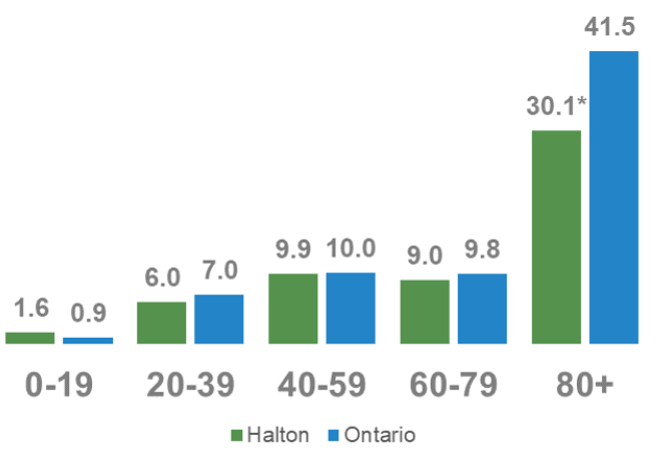 Figure 6: Age-specific rates of COVID-19 (per 10,000 population), Halton Region and Ontario, 2020 Figure 6 shows age-specific rates of COVID-19 for Halton and Ontario. Rates take into account the population size of each age group to make it possible to compare between different areas. Halton’s age-specific rates are currently similar to the provincial rates for all age groups except for residents aged 80+.
Halton has 30.1 cases per 10,000 residents aged 80+, which is statistically significantly lower than the 41.5 cases per 10,000 residents aged 80+ in Ontario overall. It is important to note that these rates will fluctuate as numbers increase throughout the pandemic, and that differences between age groups may reflect differences in the likelihood of developing symptoms and being tested.
Data limitations and data sources:
Halton case data: integrated Public Health Information System (iPHIS), extracted at 7:00 AM on April 23, 2020, to reflect data entered by the end of the day on April 22, 2020
Halton lab data: COVID Data Information System, extracted on April 20, 2020.
Ontario case data: Public Health Ontario, Epidemiologic Summary, COVID-19 in Ontario: January 15, 2020 to April 22, 2020, posted on April 23, 2020 to https://www.ontario.ca/page/2019-novel-coronavirus
Denominators for Halton and Ontario age-specific rates: Population projections [2020], IntelliHEALTH Ontario, extracted on April 8, 2020.
Data notes
All cases of diseases of public health significance diagnosed in Ontario are entered into iPHIS by local public health units. iPHIS is the Integrated Public Health Information System. It is a dynamic disease reporting system which allows ongoing updates to data previously entered. As a result, data extracted from iPHIS represent a snapshot at the time of extraction and may differ from previous or subsequent reports as data are updated.
The data only represent cases reported to public health and recorded in iPHIS. As a result, all counts will be subject to varying degrees of underreporting due to a variety of factors, such as disease awareness and medical care seeking behaviours, which may depend on severity of illness, clinical practice, changes in laboratory testing, and reporting behaviours.
Cases are included if their “diagnosing health unit” in iPHIS is Halton Region, which means counts include only individuals whose primary residence is in Halton Region. The case may not necessarily have been managed by Halton Region, if they were temporarily residing elsewhere during their case management period. Cases managed by Halton Region who normally live elsewhere but who were managed by Halton Region staff because they were temporarily residing in Halton during their case management period have not been included.
Cases for which the Disposition Status in iPHIS was reported as ENTERED IN ERROR, DOES NOT MEET DEFINITION, DUPLICATE-DO NOT USE, or any variation on these values have been excluded.
Figure 1 distinguishes between lab-confirmed and probable cases. Since April 7, probable cases are defined as epi-linked cases, meaning they are symptomatic close contacts of cases or returning travelers who have COVID-19 symptoms and therefore are presumed to have COVID-19. All other figures and numbers include both confirmed and probable cases combined.
Figures 1 and 2 use episode date, which is a field that is intended to approximate the symptom onset date for each case. It is calculated hierarchically, using symptom onset date if available; when it is not available, specimen collection date is used; if neither symptom onset nor specimen collection date are available, the lab test date is used; and finally, if none of these other dates are available, the date the case was reported to Public Health is used.
In subsequent reports, counts in Figures 1 and 2 may increase as cases are added from past dates as individuals become symptomatic, get tested, and their results are reported to Halton Region Public Health, as well as any past results are added due to delayed data entry or new arrival of lab results.
Cases are considered to be patients or residents of an institution experiencing an outbreak if they are linked to a confirmed Halton institutional outbreak in iPHIS, and they are not known to be a staff person at the institution.
Cases are considered to work in health care if they are known to have an occupation that involves caring for patients, e.g. physician, nurse, occupational therapist, recreational therapist, chiropractor, paramedic, midwife, orderly, etc. Individuals who work in health care settings but do not provide direct care to patients (e.g. managers, cleaning staff) have not been included.
Exposure type is determined by examining the exposure and risk factor fields from iPHIS to determine whether a case travelled, was a contact of a case or neither. A hierarchy has been applied as follows: Travel-related > Close contact of a confirmed case > Neither (indicating community acquisition) > Information pending.
Case outcomes (hospitalizations, recovery, deaths) reflect the latest available information reported to Halton Region Public Health and recorded in iPHIS by the extraction time.
Institutional outbreaks include outbreaks of COVID-19 in settings such as long-term care homes, retirement homes, hospitals, and prisons.
Lab testing data reflects only lab tests that have been reported to Halton Region Public Health and entered into CDIS. There may be more residents who have been tested but not reported to Public Health.
For daily Halton case tables and up-to-date information about how to protect yourself and others, please visit halton.ca/covid19
For daily provincial epidemiologic summaries and more information on COVID-19 in Ontario, please visit Ontario.ca/coronavirus
For national information on COVID-19 in Canada, please visit Canada.ca/coronavirus

|
|
 By Pepper Parr
By Pepper Parr



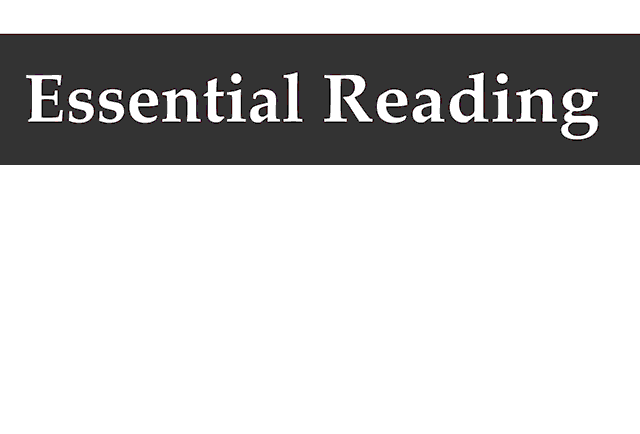

















 “Cashflow is the biggest problem”, continued Dalmazzi. “Many of our member breweries are still in their investment growth phase, and therefore marginally profitable if at all. Everyone’s doing whatever it takes to weather the storm as best they can. Fortunately, we’ve seen very few permanent closures, but that will change if current conditions extend into the summer.” continued Dalmazzi.
“Cashflow is the biggest problem”, continued Dalmazzi. “Many of our member breweries are still in their investment growth phase, and therefore marginally profitable if at all. Everyone’s doing whatever it takes to weather the storm as best they can. Fortunately, we’ve seen very few permanent closures, but that will change if current conditions extend into the summer.” continued Dalmazzi.

 “It is a joint effort by St Mathews Anglican Church, Partnering Aldershot and ECoB Ward 1, and is operated by volunteers from each organization.
“It is a joint effort by St Mathews Anglican Church, Partnering Aldershot and ECoB Ward 1, and is operated by volunteers from each organization.
 We reached out to Burlington CareMongers and asked if there were people who could make masks if the cloth was provided. We had ten positive responses before the day was out.
We reached out to Burlington CareMongers and asked if there were people who could make masks if the cloth was provided. We had ten positive responses before the day was out.




 “Last Friday was the first time doing this, and it was a wild success, with my kids participating in the workout too. I plan on making this a weekly thing, every Friday at 11:45am, with movements that people can do easily in their living rooms.
“Last Friday was the first time doing this, and it was a wild success, with my kids participating in the workout too. I plan on making this a weekly thing, every Friday at 11:45am, with movements that people can do easily in their living rooms.
























 “All four Mayors have made the commitment to keep each other apprised of decisions being considered in each respective municipality, share best practices, and coordinate when it comes to the recovery planning. They will also ensure a continued close linkage with Halton Region, with the chair Gary Carr as an invited guest to our group when his schedule permits.”
“All four Mayors have made the commitment to keep each other apprised of decisions being considered in each respective municipality, share best practices, and coordinate when it comes to the recovery planning. They will also ensure a continued close linkage with Halton Region, with the chair Gary Carr as an invited guest to our group when his schedule permits.”











